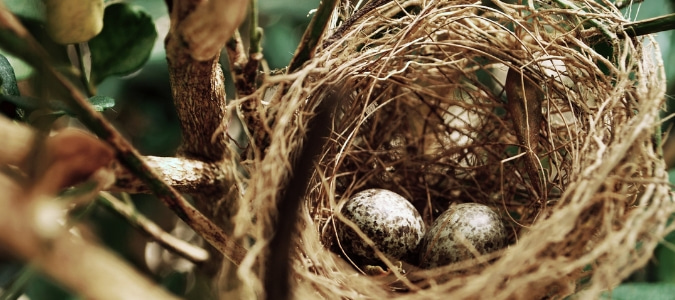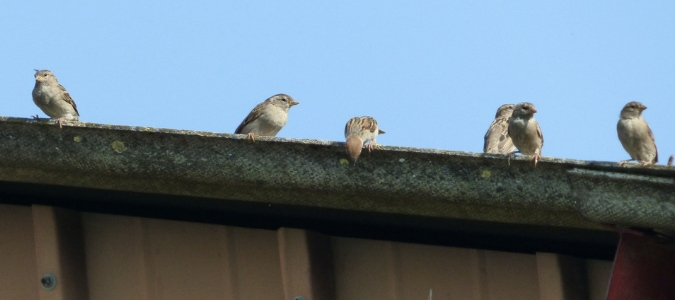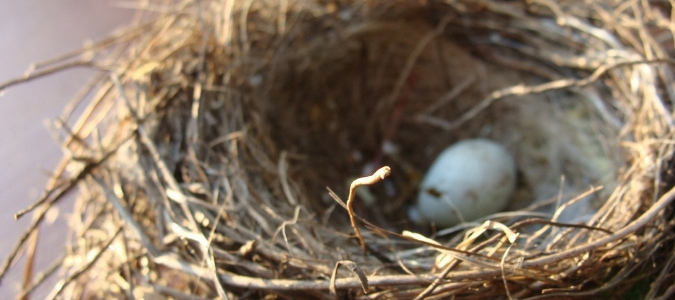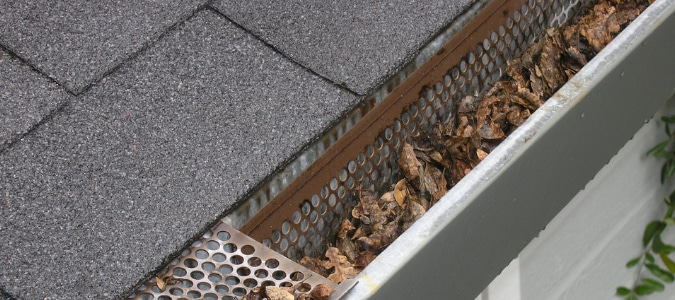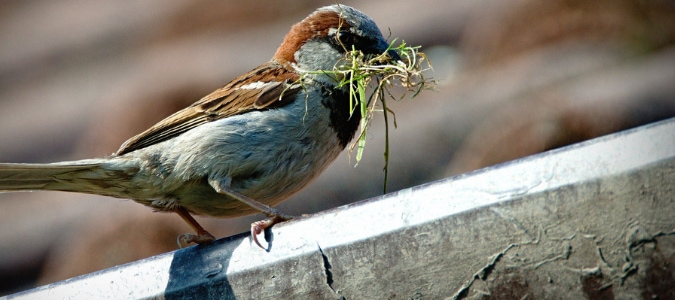
Most people understand the purpose of installing gutters around the roofline of their homes and garages: to divert rainwater from the roof and house to someplace safe, well away from any structures that could potentially sustain water damage. Pretty simple, right? Yet this standard home-maintenance task is one that many homeowners push to the back burner in favor of dealing with seemingly more pressing problems.
Part of the issue is the old saying about “out of sight, out of mind”. This is especially true with gutters, since they are located well above our line of sight. Most people can’t see the debris collecting in their gutters without going to some trouble to do so. Clogged gutters can lead to big problems down the road, however, including water damage, flooding issues, unwelcome visitors like birds and mosquitoes nesting or breeding in gutters, and more.
Following is the lowdown on how to stop birds from building nests in gutters, the reasons why blocked gutters actually are a potentially urgent issue and the importance of keeping up with this particular aspect of home maintenance.
How To Keep Birds From Making Nests In Unwanted Places
Some homeowners might think birds’ nests in their gutters are not a big problem, or even kind of cute. Birds have to build their homes somewhere, after all; they need a safe and comfortable space to lay their eggs and raise their young. Many types of birds have run out of places to build their nests due to factors like urban sprawl, which have resulted in fewer trees and other natural nest sites that birds need to survive. When you think about it, there’s nothing cuter than a nest full of tiny baby birds peeping out of delicate, cracked eggshells!
While all of the above is true, it’s still very important to know how to keep birds from making nests in unwanted places like your gutters. Keeping birds’ nests out of your gutters depends first and foremost on keeping your gutters clean.
It’s understandable why cleaning out gutters is an unappealing home maintenance task that many homeowners push to the bottom of their to do lists. Gutter cleaning is risky, dirty, sometimes extremely muddy work. Depending on the height of your home, it can be quite dangerous to clean your gutters yourself; you may not even have a ladder tall enough to do the job properly.
These are just a few of the reasons why many homeowners let their gutters go, especially if their home or property doesn’t have obvious drainage problems. Savvy homeowners, however, know that keeping their gutters clean should be a top priority on the list of regular home maintenance tasks. Cleaning the gutters is just one of the things you should do to keep your home and yard in good shape and prevent damage from occurring over time—the type of damage that will definitely need an urgent, and often expensive, fix.
The best way to deal with birds nesting in unwanted places is to discourage or prevent them from doing so in the first place. Keeping your gutters clear of leaves, sticks, mud and other debris that birds use in building their nests can go a long way toward deterring these animals from making a home in your gutters. Here are a few other prevention methods that can be helpful in keeping birds from making nests in unwanted places. Note that these methods should be used only when you have ensured that no birds or eggs are present in the spaces you’re trying to keep bird-free, so birds won’t get trapped inside:
- Install gutter guards made of wire mesh, plastic screen or surface-tension material on your existing gutters.
- Use steel wool to seal off any holes or gaps in your roof, eaves, porch or other areas where birds might build nests. Reinforce the steel wool by covering it with wood or metal to ensure the area is truly sealed off.
- Replace old gutters with a new version that is more efficient at keeping out birds and debris.
- Install birdhouses or nesting boxes and bird feeders on your property to provide birds with safe places to eat and build their nests.
It is also a good idea to keep trees trimmed well away from your house, so leaves, sticks, pine needles and other types of debris have less chance of finding their way into your gutters.
Gutters aren’t the only place birds can stick around in and around your home. Homeowners often wonder how to get rid of birds in the attic after finding a nest or other evidence that one of these creatures has found its way inside. Birds can enter these spaces, chimneys and windows looking for protection from the elements. Using steel wool to keep birds out works in these areas as well. Showing a bird the way out may depend on whether you have a window to open or another easy way to allow the bird to fly out on its own. In other cases, a wildlife expert may be your best bet to evite these unwelcome houseguests from these spaces.
How To Get Rid Of Birds Nesting In Roof
If you have birds nesting in your gutters or other unwanted places, it is important not to disturb the nest while they are actively nesting, which is typically from spring through early fall. More than 800 bird species are protected by law in North America, which makes it illegal to kill them, trap them or disturb their nests during nesting season. This is why it’s important to wait until late fall or winter if you need to clear a bird’s nest from your gutters—or, better yet, discourage them from nesting in the first place.
While it is illegal to kill birds, trap them or disturb their nests during nesting season, you are legally allowed to stop a nest in progress. If you spot a bird in the beginning stages of building a nest in your roof or gutter, you’ll have to act quickly to remove the debris before the bird can complete the job.
If a bird has already built a nest in your roof, gutter, eaves or any other unwanted spot, you can’t simply knock the nest down. It’s even illegal to move it to a different spot on your own property. Aside from legal issues, it can be dangerous to your health to disturb a bird’s nest, as many birds carry mites and other diseases that can affect humans. The best way to get rid of birds nesting in your roof is either to call in a wildlife rescue or pest control specialist to address the problem. Your other option is to wait until late fall or early winter when nesting season is over and you can safely remove the nest. At that point, you should also take steps to prevent any future nest-building activity.
Found A Bird’s Nest In A Gutter? Here’s What To Do
If you’ve found a bird’s nest in your gutter and it’s during nesting season—anytime from spring through early fall—don’t try to remove it yourself. There may be nesting birds, eggs or baby birds inside, and federal law protects many birds and their nests from being killed, trapped or otherwise disturbed. Your best bet, in this case, is to call a trusted pest control company or your local wildlife removal service to handle the problem legally and humanely.
If you find a bird’s nest in your gutter and it is late fall or wintertime, you are legally allowed to remove it yourself. If you do, be sure to wear protective gear, including gloves and a mask over your nose and mouth, to protect yourself from the mites and diseases that many birds carry. Once you’ve removed a bird’s nest, you’ll also need to take steps to prevent birds from returning to the same spot once nesting season begins the following spring.
Clogged Gutters: Problems And Solutions
Why are clogged gutters such a problem, and clean gutters so important? Allowing debris to collect in gutters can quickly lead to solid blockages that impede the flow of rainwater, preventing it from traveling its intended course through the gutters to downspouts and away from your home. Gutter blockages can result in water collecting and either seeping or spilling over into areas where you definitely don’t want it to be.
When water collects where it shouldn’t, it can cause moisture damage to your roof or exterior walls, or even to the interior walls and internal wooden frame of your home or garage—but even that isn’t all. Clogged gutters can actually cause problems in dry weather, as well. Here are just a few of the issues that clogged gutters can cause over time:
- Moisture damage to the interior or exterior walls of your home or garage
- Drainage issues that could cause a flood on your property or a neighbor’s
- Pest control problems (as mosquitoes and other unwanted pests breed in the standing water inside blocked gutters and downspouts, as well as in the resulting pools that form after a rainstorm, many homeowners find themselves researching how to keep mosquitoes out of your yard)
- Birds nesting in your gutters
- Collapsed gutters that must be replaced when they can’t support the weight of standing water and decomposing plant matter
Did you know clogged gutters can even lead to “volunteer” weeds or other plants growing along your roof line? Just imagine: Dead leaves and other plant matter mix with rainwater in your gutters and break down over time, turning into rich, damp humus (organic matter, or, more simply, soil). Meanwhile, plant seeds waft through the air on the breeze, and birds and squirrels also munch on seeds from your garden or neighborhood, which then pass through their digestive tracts. When the wind blows in the right direction—or when wild animals “do their business” in your gutters—seeds are deposited into the rich soil that has been developing there. Et voilà: A little soil plus some wayward seeds equals a volunteer garden in the last place you wanted one to grow.
Even if you live in a drier climate, clogged gutters can still break down and collapse under the weight of the plant matter that collects in them. This is an expensive fix and one that is easily avoidable if you clean the gutters on a regular basis, or pay a reputable company to maintain them for you. In fact, all of the potential problems listed above have the same, relatively simple solution, and it’s rooted in the old saying about an ounce of prevention being worth a pound of cure: Keep your gutters clean, and you are unlikely ever to face any of the issues associated with clogged gutters.
ABC Can Clean Your Gutters—and More
Routine gutter cleaning may be simple on paper, but the truth is, it’s no easy task to clean them yourself. The taller your home, the truer this becomes, since gutters are installed at the roofline, which can be quite high on two- and three-story homes. It is recommended that gutters be cleaned and inspected at least every six months, in the late spring and again in the late summer or early fall, but homeowners with pine trees that drop needles near their roof lines should consider quarterly inspections and cleanings.
Do-it-yourself gutter cleaning can be dangerous, as it typically involves spending a good chunk of time repeatedly climbing up and down a tall ladder while wielding a trowel, hose, bucket and other unwieldy items. The job might involve several different tools and pieces of equipment, including some or all of the following:
- A sturdy ladder that extends high enough to get you safely to the level of your roofline
- Work gloves to protect your hands from sticks, metal edges and anything else that might pose a danger
- A trowel, small scoop or other tools to scoop out leaves and debris
- A bucket or plastic tarp to catch/hold debris
- A long hose with a high-pressure nozzle to spray debris out of the gutter that is too fine to scoop out by hand, and also to flush out downspouts
- Alternatively, a hook-shaped gutter-extender tool that attaches to your hose, so you can stand on the ground and extend your hose up to the height of the gutter (this works best on one-story homes)
- A plumber’s snake to clear any debris that has become lodged in the downspouts
If all of the above doesn’t seem like something you can safely or reasonably handle on your own, call on ABC Home & Commercial Services to help. Our home maintenance experts can recommend a gutter inspection and cleaning schedule that is tailored to your home’s specific conditions and needs. We also have trained pest control specialists that have tried-and-true, humane ways of dealing with birds’ nests in gutters, roofs and other unwanted places. We can use prevention techniques to keep birds as well as debris out of your gutters and keep your gutters in prime working condition.
